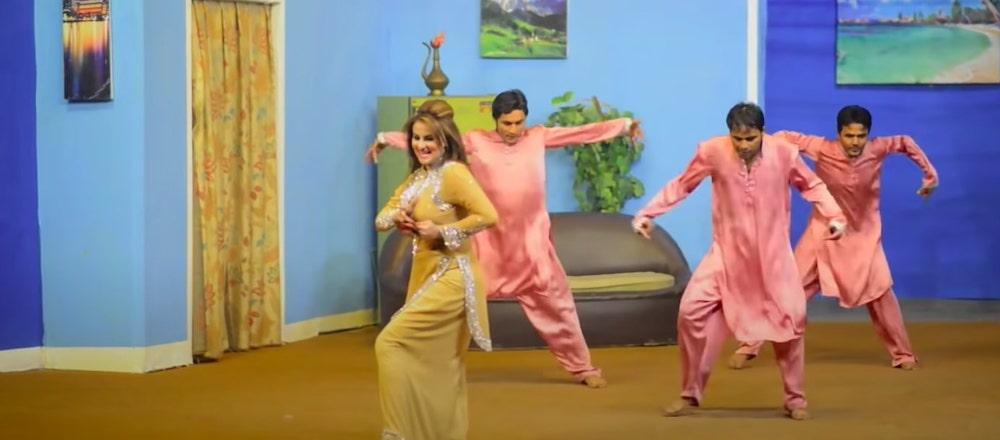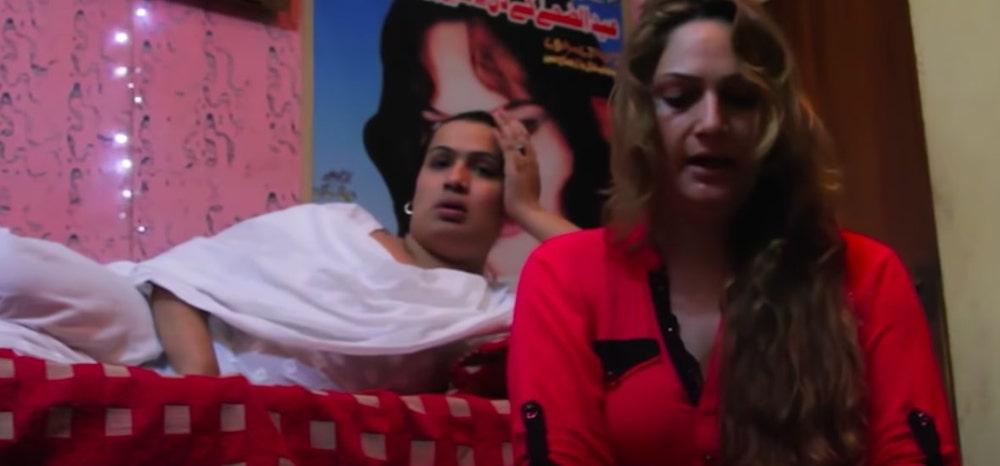Glitz, Glamour and Guns: Codification of Gender in Showgirls of Pakistan
Showgirls of Pakistan, a documentary film by Saad Khan, introduces us to the contemporary world of Pakistani mujra through the performers Afreen Khan, Uzma Khan and Reema Jaan. Mujra is a dance form that dates back to the Mughal Empire—performed in precolonial royal courts—but was eventually criminalised under British rule. The performers have been known by a variety of names in different regions—such as nautch girls and tawaifs—owing to the dance form’s widespread influence and the value the performers produced in the cultural landscape of the Mughal Empire. Despite being stigmatised through the colonial lens and considered to be “vulgar,” mujra continues to be a popular dance form today. It is performed in Pakistan and India for public viewing in theatres and dive bars, besides private parties—drawing in working-class to middle-class male audiences.

The starting montage features shots from energetic performances by Afreen Khan as part of different public and private events.
Pakistan saw the commercial market for the dance form open up in the 1980s during the reign of military dictator Muhammed Zia ul-Haq, during a time when he introduced censorship laws in the name of religious orthodoxy. This was also around the time when Sharia law came to be in Pakistan, officiated in 1991, and carried forward by the successive dictatorial leader General Pervez Musharraf.

Afreen Khan Performing.
The documentary looks at former red-light-district areas in the cities of Lahore, Faisalabad and Multan, where mujra is contemporarily performed in public theatres, though heavily censored. Through an omnipresent series of news reports in the background, we are made aware of the helm of violence at which these women stand in order to make a living. Often the sole breadwinners in their family, the women depicted are from working class backgrounds. Thus, mujra provides them with a route towards socio-economic mobility. We are informed of the sheer number of performers—Anjuman Shehzadi, Madam Saima, Shahmeen, Kismet Baig, Ayesha Chowdhury, Arzoo—who have faced violence in the form of head shaving, molestation, shooting, kidnapping and murder. The nation state—with its incessant censorship and publicly held opinion around morality and “vulgarity” as stated alongside the news reports—paired with violently misogynistic men, make for an extremely hostile everyday environment for these women. Public space becomes one of violence.

Reema Jaan, a member of the Khwaja Sira Community, is shown in her home.
During public performances in theatres, guidelines are slapped onto dress codes and conduct. In Lahore especially, officers from the Ministry of Culture and other government departments are sent to ensure that the performers adhere to them. Mujra dancers are required to wear full length bodysuits that do not show any cleavage. Afreen Khan was also banned from stage on multiple occasions due to “lewd” dance moves. Outside of Lahore, men come armed with guns. The daily threat of overt violence is pervasive. Afreen receives anonymous calls and Uzma receives threats from her manager-turned-boyfriend Imran. Imran is just one of the devious managers, a nosarbaaz (a term almost fondly used by Saad Khan, over a video conversation) or swindler who tries to cheat his clients.
The constant policing of female and nonconforming bodies is a theme that runs through the documentary, whether it is the nation-state or the larger community. Showgirls of Pakistan is made in a time informed by the “honour killing” of social media celebrity Qandeel Baloch by her brother, that made international news in 2016. Though beyond the scope of Showgirls of Pakistan, the backlash and violence that Baloch was subjected to is a reminder of the consequences of free sexual expression in the public space.

Reema Jaan in Conversation.
Reema Jaan being ousted from her Khwaja Sira community—for not adhering to certain community codes—is a case of public shaming that stands true to the kind of social humiliation that takes place as communities become state actants in policing. Khwaja Sira is the Pakistani-Urdu umbrella term for the third-gender and transgender community in the South Asian context. Khan, in conversation with me, described the Khwaja Sira as being a colonial confinement of the historically fluid identity. There is a certain “bioessentialisation” that takes place in their marginalisation, defining which genders are socially acceptable and which are not. As Khan explains to me, Reema’s toli scene in the documentary, where she performs badhai or blesses a newly born child in the locality—a socio-culturally encouraged practice—becomes an important lens to view their contradictory, postcolonial position as divine yet “deviant” from the gender norms.

Uzma Khan Getting Ready Before a Performance.
The Khwaja Sira or Hijra communities historically have been aligned with art and spirituality, where Allah or God is said to have created the man, the woman, and the Khwaja Sira as a “special being.” This history has been buried by the British, Khan explained. Speaking further, he said that in the enactment of the toli (a blessing dance), Khwaja Sira are saying that the male is not her, and that she has “…deliberately shed the skin” to perform this deeply spiritual act.
Khwaja Sira are depicted in a series of subversions through the Showgirls of Pakistan. Yet, one cannot enter their world in full, as they use Farsi as a “crypto-language” common to the community in North India and Pakistan. There is a sequence where the community is first introduced, as a train goes over tracks, which Khan described as going “…over the gaze” of the outsider or the normative, socially and politically accepted genders.

Afreen Khan is provided with studio space by the director to shoot her own version of a music video. The act of the swallowing of a snake is highly sexual and codified with the language of danger, taming and subversion.
There are many subversions through the film, as the mujra dancers are shown to perform joyfully and fiercely. This is especially so in the interspersed sections where they are able to assert their creative freedom in a studio setting, as they direct and shoot their own music videos. Afreen Khan is shown in sensational full vigour as she lasciviously takes a snake in her mouth, indicating danger and desire. The mujra dancers’ highly individual personalities come through, as they are nonconforming women who make their way through their worlds with swearing, cunning, glamour and ferocity.
Watch the film here.
To read more about Showgirls of Pakistan, please click here.
All images from Showgirls of Pakistan by Saad Khan. 2020. Images courtesy of the artist.




